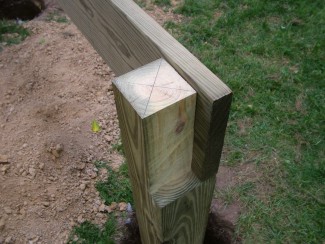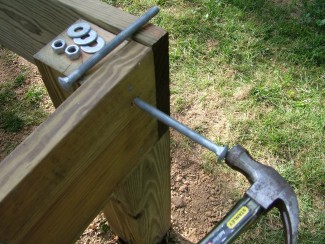When I go to friends' houses and open houses, I am often shocked to see how do-it-yourselfers and even paid contractors attach deck beams to wooden posts. What astonishes me is the lack of forethought into the amount of weight that is supported by two simple deck posts. Anyone who has lifted a single 2x12 treated-lumber floor joist knows that the cumulative weight of a deck can easily be in the thousands of pounds. Then imagine what happens when you have a large party and people are shoulder to shoulder on the deck.
The bottom line is that you can have multiple tons of weight constantly trying to fall to the ground under the influence of gravity. Each year, there are people who get seriously injured and even die from deck collapses. The reasons for the structural failures are many, but there is no reason for them to be related to the beam/deck post connection.
 |
| Many decks require beams be attached to supporting posts. Notching a wood post to accept a beam is but one way to make this connection. |
The beam you are working with often supports half or more of the weight of the deck, and anything that will eventually be on the deck. The floors joists, decking, furniture and people rest on the beam, and transfer the load to this beam along its entire length.
Frequently, I see people who have taken a beam or two joists and simply nailed or bolted these parts to the sides of the post. The entire weight of the deck is born by four or more simple bolts or nails. These fasteners may not be designed to handle the weight. If the lumber dries and shrinks, this connection can become significantly compromised. I prefer to have deck beams rest directly on a shelf or notch in a slightly oversized wooden-deck post. This notch is easy to create with a standard circular saw and a traditional hand saw. Many decks beams are comprised of two 2x12 deck joists that can carry the design load. The joists don't have to be placed immediately next to one another to support the load of the deck. They can be spaced several inches apart with an air space that helps prevent rot.
I have created this connection in the past by using a 6x6 inch wooden deck post. These posts normally measure five and five-eighths inches square. The thickness of the two floor joists is a little over three inches, so when you create two notches on opposite sides of the post, you are still left with a beefy two and one-half inches of post material. This remaining tongue of wood extends to the top of the beam.
 |
| Through bolts that use washers and nuts permanently attach the beam to the notched post. |
The two parts of the beam are through bolted to the wood post to make a strong and permanent connection. The entire weight of the deck rests on the bottom of the notches in the post, instead of hanging precariously on four or more bolts.
You can also buy code-approved metal brackets that allow you to connect wood deck beams to wooden posts. I have used these when they are specified by an architect or a homeowner. These brackets are easy to work with, and will do a good job of making the connection.
Never guess on the beam size for a deck. If you are unsure of the size and span, have it specified by a residential structural engineer or architect. The small cost to get the right structural plan is well worth it. You also need to be highly concerned with how the deck attaches to the house, and know all about important diagonal bracing both under the deck and possibly at the beam/post connection.
Many decks have collapsed when a group of people starts dancing on the deck. The decks develop a harmonic movement that causes them to sway back and forth. If not properly braced, a deck can rack and collapse with little or no warning.
For all your decking needs call-- 405-590-1719 or email us at kingremodeling1@live.com